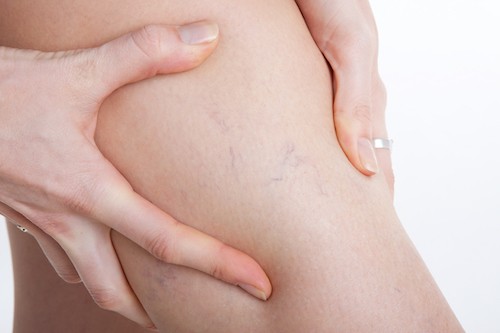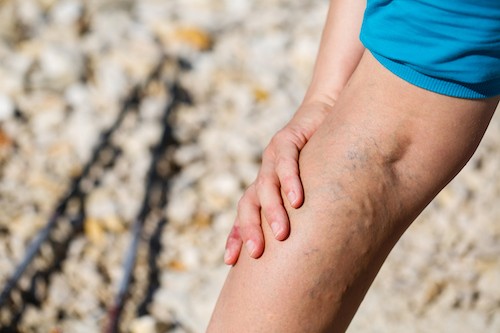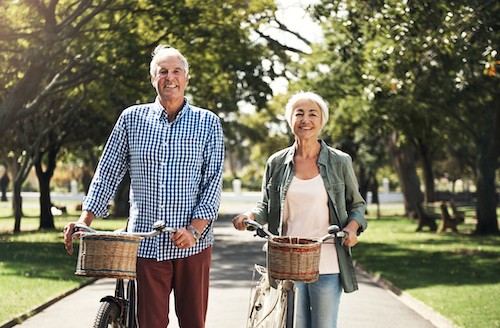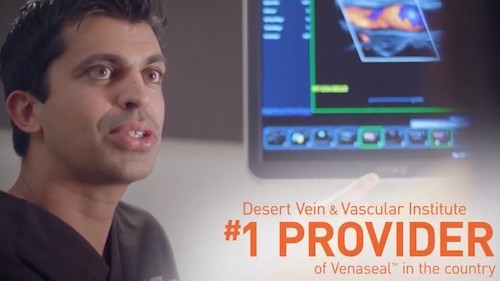When varicose veins first appear, they can be completely painless, but over time many people start to notice painful symptoms which can be quite distressing. There are four stages of development that varicose veins progress through, with each having different symptoms. To understand what varicose vein leg pain feels like it’s helpful to look at what is happening during each stage and how that might contribute to your varicose leg pain.

Stage 1: Spider Veins
In the first stage small veins, about 2mm or less in width become visible but do not protrude above the skin surface. These are aptly named spider veins for their spider web appearance. Some people experience burning and itching sensations from spider veins while others experience no noticeable discomfort. However, spider veins may indicate a more serious underlying vein insufficiency problem and it is advisable to get an evaluation at this stage to find out if more trouble might be brewing under the surface.

Stage 2: Varicose Veins
In the second stage, larger veins that swell and bulge above the skin surface start to appear and these are what are commonly referred to as varicose veins. While you may remain pain-free, increased inflammation at this stage often causes pain and discomfort to set in. Symptoms to look out for include aching, heaviness, and burning or itching sensations that tend to increase after long periods of standing or sitting in one position.
Stage 3: Swelling
As leg vein blood flow becomes increasingly sluggish, the pressure in the veins rises, causing further weakening and expansion of the affected veins and leakage of fluid into the surrounding tissues. At this third stage, you may begin to develop noticeable swelling in your ankles or legs, or both. Often the swelling is accompanied by sensations of heaviness, pressure, and tightness, especially towards the end of the day. Additionally, you may experience leg cramps, which tend to occur at night[1]. You may also develop nocturnal restless legs, causing you to move your legs frequently while attempting to sleep to attempt to alleviate the discomfort of your varicose veins. These symptoms can disturb your sleep and lead to other health complications[2].
Stage 4: Skin Changes
In the fourth stage, painful sores or wounds called venous ulcers may develop on the skin due to continued fluid build-up in the legs. This often occurs around the ankles or shins. Venous ulcers are slow to heal and even with diligent treatment can take up to 11 months to fully mend. Venous ulcers also cause a type of skin discoloration from red blood cells that leak out of the veins into surrounding tissues and release iron-containing hemoglobin. As the hemoglobin degrades, it produces a dark brownish compound that stains the skin, causing a bruise-like appearance. Though venous ulcers and skin discoloration issues are rare, it is critically important to do everything you can to avoid these symptoms by getting proper treatment at the earliest possible stage.
How to Get Relief from Varicose Vein Pain
There are a number of simple, practical steps you can take to reduce your varicose vein symptoms, improve blood flow, and possibly slow the progression of varicose veins.
Elevate your Legs
An easy and effective way to obtain relief when your legs are tired, aching, swollen, or painful is to elevate them. This reduces swelling and pressure and assists with blood return to the heart. Harvard Health Publications recommends raising your legs so they are higher than your heart for 30 minutes twice per day[3].

Exercise
The best way to get your blood moving and improve return blood flow from the legs is to exercise, particularly focusing on activities that contract your calf muscles. Muscle contraction gently compresses the veins and assists in moving blood through them. Your veins rely on this mechanism since they lack muscular walls and have only valves to prevent the backward flow of blood.
- Walking is one of the best exercises for the calf muscles. If your symptoms limit your ability to walk long distances start slowly under the supervision of your doctor and you will likely be able to increase your walking time and distance gradually.
- Swimming is also a great option. The buoyancy of the water reduces the effects of gravity and acts as a mild form of compression against your legs, making it much easier for blood to flow through your legs as you exercise.
Wear Compression Stockings
Compression stockings hug your legs and gently compress the veins, assisting blood flow toward the heart while preventing the pooling of blood. They can help prevent your ankles from swelling and reduce the achy, heavy sensation that often accompanies swelling. Compression stockings may also help with restless legs and nighttime muscle cramping. Wearing calf-length compression stockings has been proven to reduce or even prevent evening swelling that occurs after a long day of sitting or standing at work[4]. They should always be put on first thing in the morning before you get out of bed.

Get Treatment
If your varicose veins are progressing or causing you pain that interferes with your work and enjoyment of life, Desert Vein and Vascular Institute has solutions. You can reduce or eliminate leg pain by having your veins treated by a qualified vascular surgeon. All our procedures are performed in-office and have fast healing times. You will likely even be able to return to your normal daily activities right after your procedure!
To learn about which vein treatment is right for you, we invite you to schedule a free vein screening consultation at Desert Vein and Vascular Institute. All of our physicians are board-certified vascular surgeons who specialize in helping people like you.
Desert Vein and Vascular Institute is the top provider of VenaSealTM, the leading outpatient varicose vein treatment, in the USA. Schedule a free consultation today by calling 1-800-827-4267.
References
- Prevalence and characteristics of muscle cramps in patients with varicose veins. Vasa, 2000. 29(4): p. 269-73
https://pubmed.ncbi.nlm.nih.gov/11141650/ - Nocturnal leg symptoms are not associated with specific patterns of superficial venous insufficiency. Int Angiol, 2017. 36(6): p. 565-568
https://pubmed.ncbi.nlm.nih.gov/28854778/ - Varicose veins. December 2014; Available from:
https://www.health.harvard.edu/skin-and-hair/varicose-veins2. - Compression stockings reduce occupational leg swelling. Dermatol Surg, 2004. 30(5): p. 737-43; discussion 743
https://pubmed.ncbi.nlm.nih.gov/15099316/
